Celtic Claims
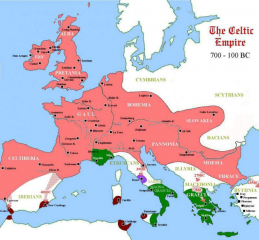 This view of the pre-Roman “Celtic Empire” is commonplace. It is however challenged by the recent work of archaeologists such as Barry Cunliffe, and a wide range of geneticists.
This view of the pre-Roman “Celtic Empire” is commonplace. It is however challenged by the recent work of archaeologists such as Barry Cunliffe, and a wide range of geneticists.
East and West
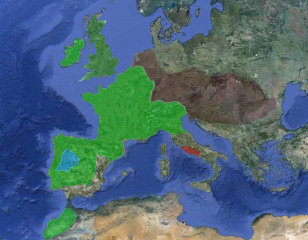 The genetic evidence is that the tribes known as “Celtoi” by the Greeks may in fact have been many different peoples, who spoke similar languages, an traded goods and artefacts. Thus there may have been at least two major groupings, east and west.
The genetic evidence is that the tribes known as “Celtoi” by the Greeks may in fact have been many different peoples, who spoke similar languages, an traded goods and artefacts. Thus there may have been at least two major groupings, east and west.
From the Ocean
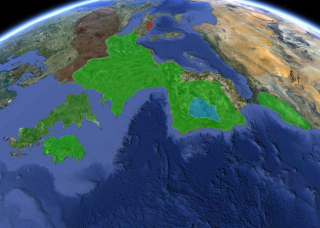 Barry Cunliffe is adamant that one subgroup occupied the atlantic coastline from Northern Ireland to North Africa and that it was different from other groups described as Celts.. (For more information on his findings see -Facts And Opinions – Tutankhamun – Opinions – The Basque Anomaly.
Barry Cunliffe is adamant that one subgroup occupied the atlantic coastline from Northern Ireland to North Africa and that it was different from other groups described as Celts.. (For more information on his findings see -Facts And Opinions – Tutankhamun – Opinions – The Basque Anomaly.
Geography
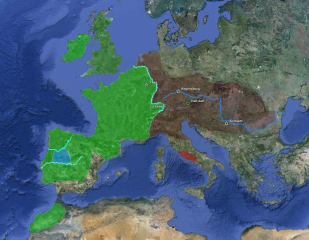 The question then is where to draw the line between east and west? The Treveri, the clan who originally occupied the land where the roman city of Augusta Treverorum was located (Trier) were reported by St Jerome to speak a language similar to that spoked by the Celts in Galatia(Modern Turkey) and the celts in Galacia were certainly “Eastern Celts.” He should have known as he visited both places. the rives are; the Rhine running north/south and the Danube running east /west. In Hispania the rivers are the Duro and the Targus. La Tene and Halstatt are two prominent locations of “Celtic culture” but there are significant differences between the two.
The question then is where to draw the line between east and west? The Treveri, the clan who originally occupied the land where the roman city of Augusta Treverorum was located (Trier) were reported by St Jerome to speak a language similar to that spoked by the Celts in Galatia(Modern Turkey) and the celts in Galacia were certainly “Eastern Celts.” He should have known as he visited both places. the rives are; the Rhine running north/south and the Danube running east /west. In Hispania the rivers are the Duro and the Targus. La Tene and Halstatt are two prominent locations of “Celtic culture” but there are significant differences between the two.
Multicultural Hispania
 The romans, and modern historians were very clear that in Hispania (modern Spain and Portugal) there were not only Celts but several other racial groupings. Most notable is the grouping described as “Pre- Celtic” which is the only peoples identified as such but did perhaps exist elsewhere.
The romans, and modern historians were very clear that in Hispania (modern Spain and Portugal) there were not only Celts but several other racial groupings. Most notable is the grouping described as “Pre- Celtic” which is the only peoples identified as such but did perhaps exist elsewhere.
Hispanic Clans
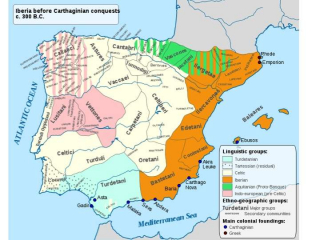 Even within the main Hispanic racial groupings there were many different clans (or tribes if they were not celtic). These different tribes sometimes worked in concert with each other but more often did not.
Even within the main Hispanic racial groupings there were many different clans (or tribes if they were not celtic). These different tribes sometimes worked in concert with each other but more often did not.
Gallic Clans
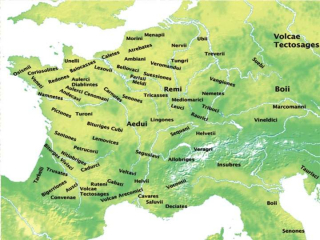 There was an equally large number of different clans in Gaul. TheCelts in Hispania, Gaul, Britain, Ireland and the Danube did however all have similar organisational structures. They all accomodated the recognition of “High Kings”, The tyranny of distance ensured however that the High King recognised in Britain would not be recognised in Hispania or on the Danube. This had long term implications for the stability of the Roman Empire, which set it self the task of governing them all.
There was an equally large number of different clans in Gaul. TheCelts in Hispania, Gaul, Britain, Ireland and the Danube did however all have similar organisational structures. They all accomodated the recognition of “High Kings”, The tyranny of distance ensured however that the High King recognised in Britain would not be recognised in Hispania or on the Danube. This had long term implications for the stability of the Roman Empire, which set it self the task of governing them all.
Brutus
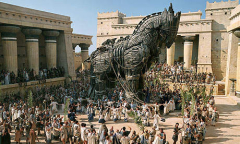 As an aside, there are legends in Britain of another descendant of Aeneus, Brutus who founded the British state. The same british legend stipulates that the original name for London was “New Troy”
As an aside, there are legends in Britain of another descendant of Aeneus, Brutus who founded the British state. The same british legend stipulates that the original name for London was “New Troy”
There is also an academic opinion (including Sir Moses Finley, a professor of ancient history at Cambridge University) that all the Celts had their origins in Troy but that the real Troy was near modern Cambridge in England. This should not be dismissed as fantasy. Sir Moses was a serious historian who attemped to quantify his findings. Much of his work is summarised in “Where Troy Once Stood” by Iman Jacob Wilkens republished in 2009 by Gopher Publishers
Sir Moses Finley also had had collection of his essays published under the title of “The use and abuse of history”. He said of classical historians
“Classical historians are by long tradition often men who are not in the first instance historians but men trained in language and literature who call themselves classicists. . . and classical philologists, [etc.]. . . . Classicists by definition do not have the habit of thinking about history and historical problems other than those on which they happen to be working, do not, by and large, even read history in a serious way outside the ancient field. Their general historical views . . . are in a sense fixed in their school-days, and those make up their basic assumptions, their subsurface generalizations, from which they proceed to classify and order events and institutions of the ancient world.”
Thus Roman origins are are by no means certain. By extrapolation from the work of Professor Finley, it is not impossible that the Romans themselves were a Celtic tribe, something that if true, they steadfastly refused to acknowledge.
